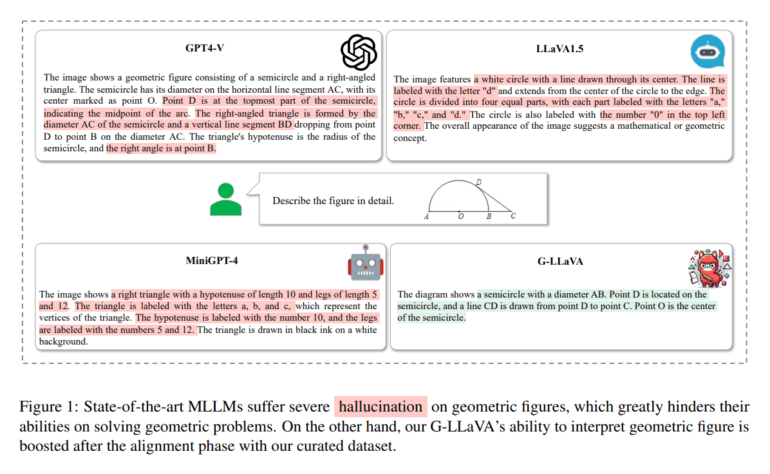TL;DR:
- Researchers from Huawei Noah’s Ark Lab, The University of Hong Kong, and The Hong Kong University of Science and Technology introduce G-LLaVA, a revolutionary model.
- G-LLaVA leverages the Geo170K dataset to excel in solving complex geometric problems.
- Geo170K dataset bridges the gap in understanding geometric figures and enables accurate geometry solutions.
- G-LLaVA combines an LLM and a vision transformer, outperforming other MLLMs with fewer parameters.
- The evaluation shows G-LLaVA’s exceptional accuracy, surpassing models like GPT4-V and Gemini Ultra.
- G-LLaVA consistently outperforms baseline models across various types of geometric questions.
Main AI News:
In recent years, Large Language Models (LLMs) have exhibited extraordinary capabilities in human-level reasoning and content generation. Their versatile applications span across text generation, summarization, translation, and more. Recognizing this expansive potential, a collaborative team comprising researchers from Huawei Noah’s Ark Lab, The University of Hong Kong, and The Hong Kong University of Science and Technology has embarked on a pioneering journey to explore the integration of LLMs in mathematical problem-solving. This research paper delves into their groundbreaking endeavor, focusing specifically on harnessing the power of LLMs to tackle intricate geometric problems.
While extensive research has been conducted on utilizing LLMs for mathematical problem-solving, the emphasis has predominantly rested on text-based conundrums, often overlooking geometric complexities. Geometric problem-solving necessitates a nuanced understanding of geometric figures—an aspect where existing models exhibit limitations. To bridge this gap, the authors of this research paper introduce a multimodal geometry dataset named Geo170K and an ingenious model christened G-LLaVA, designed to leverage this dataset for proficiently unraveling geometric enigmas.
Many cutting-edge multimodal large language models (MLLMs) face challenges, particularly in the form of hallucinations, when confronted with geometric problem-solving tasks. One of the key contributing factors to this challenge is the absence of a comprehensive descriptive dataset. In response, the researchers have meticulously crafted Geo170K, an extensive repository comprising thousands of geometric image-caption pairs and corresponding question-answer pairs. This dataset not only furnishes detailed geometric image descriptions but also encompasses a diverse array of problem-solving methodologies. This comprehensive resource equips MLLMs with the essential knowledge needed to grasp fundamental geometric principles and generate precise geometry solutions as per user instructions.
The culmination of this research endeavor is G-LLaVA—an MLLM meticulously sculpted from the wealth of data within the Geo170K dataset. The nomenclature of G-LLaVA is emblematic of its architecture, which seamlessly integrates a Large Language Model (LLM) with a vision transformer (ViT). Furthermore, the model’s training unfolds in two distinct phases: geometric visual-language alignment and geometric instruction-tuning. This innovative pairing of dataset and model architecture elevates G-LLaVA to the status of an exceptional tool for conquering geometric challenges, all while surpassing many state-of-the-art MLLMs, even with fewer parameters.
For rigorous evaluation, the researchers subjected their model to a comparison with other MLLMs using the MathVista benchmark. The results illuminate G-LLaVA’s exceptional prowess as it outperforms stalwarts like GPT4-V and Gemini Ultra. G-LLaVA-13B boasts an impressive accuracy rate of 56.7%, a stark contrast to the 50.5% and 56.3% scores achieved by the two aforementioned models, respectively. In addition, the research team conducted comparative analyses of G-LLaVA against baseline models across various question types, including angles, lengths, and area problems. The verdict was unanimous—G-LLaVA consistently emerged as the top performer in all categories of questions.
Conclusion:
G-LLaVA’s emergence as a formidable geometric problem-solving tool, powered by the Geo170K dataset, has the potential to disrupt the market for mathematical problem-solving solutions. Its exceptional performance, particularly in comparison to established models, positions it as a game-changer in the field. This innovation promises to open new avenues for businesses and educational institutions seeking reliable and accurate geometric problem-solving capabilities.

